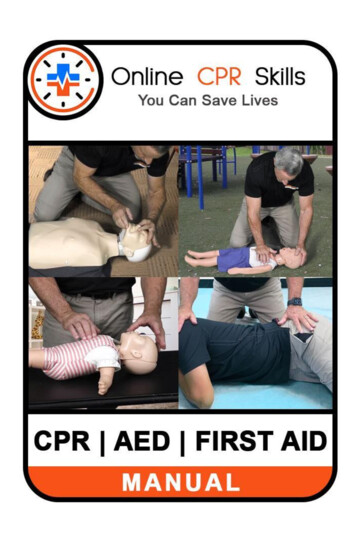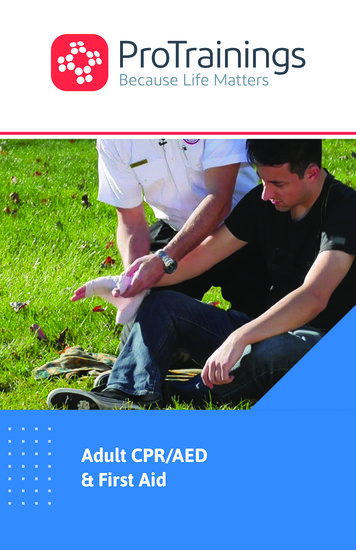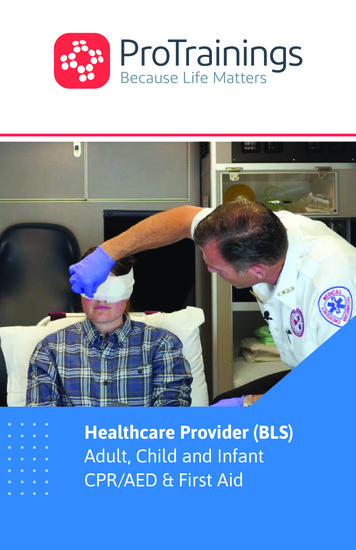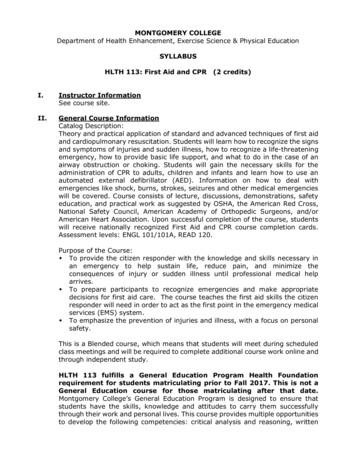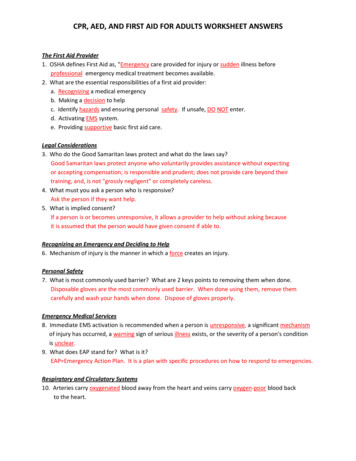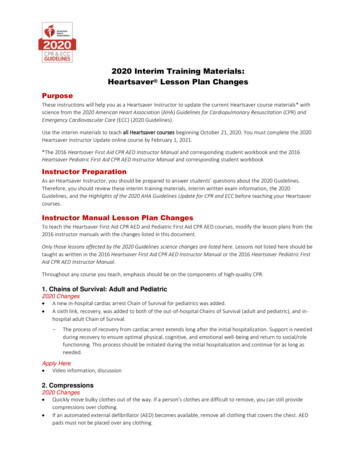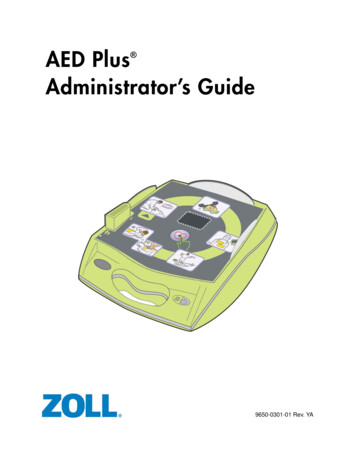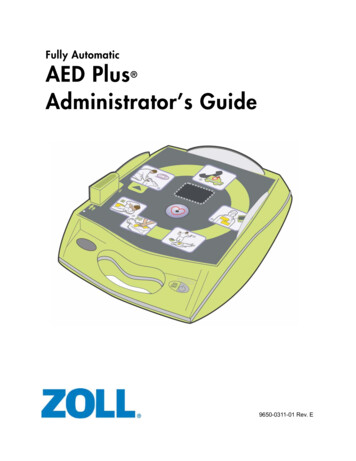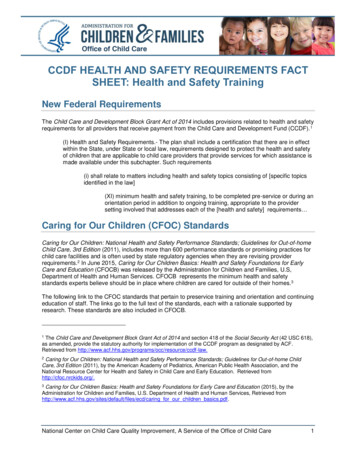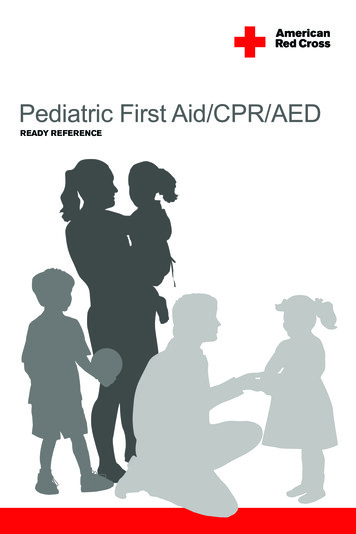
Transcription
Pediatric First Aid/CPR/AEDREADY REFERENCE
CHECKING AN INJUREDOR ILL CHILD OR INFANTAPPEARS TO BE UNCONSCIOUSTIPS: Use disposable gloves and other personal protectiveequipment whenever giving care. Obtain consent from parent or guardian, if present.AFTER CHECKING THE SCENE FOR SAFETY, CHECK THE CHILD OR INFANT:CHECK FOR RESPONSIVENESSTap the shoulder and shout, “Are you OK?” For an infant, you may flick the bottomof the foot.CALL 9-1-1If no response, CALL 9-1-1 or the local emergency number. If an unconscious child or infant is face-down, roll face-up, supporting the head,neck and back in a straight line.If ALONE—Give about 2 minutes of CARE, then CALL 9-1-1.If the child or infant responds, CALL 9-1-1 or the local emergency number for anylife-threatening conditions and obtain consent to give CARE. CHECK the child fromhead to toe and ask questions to find out what happened.PANEL2
OPEN THE AIRWAYTilt head back slightly, lift chin.CHECK FOR BREATHINGCHECK quickly for no more than 10 seconds. Occasional gasps are not breathing. Infants have periodic breathing, so changesin breathing pattern are normal for infants.GIVE 2 RESCUE BREATHSIf no breathing, give 2 rescue breaths. Tilt the head back and lift the chin up. Child: Pinch the nose shut, then make acomplete seal over child’s mouth. Infant: Make complete seal over infant’smouth and nose. Blow in for about 1 second to make thechest clearly rise. Give rescue breaths, one after the other.TIPS: If you witnessed the child or infant suddenlycollapse, skip rescue breaths and start CPR(PANEL 7). If the chest does not rise with rescue breaths,retilt the head and give another rescue breath.QUICKLY SCAN FOR SEVERE BLEEDINGWHAT TO DO NEXT IF THE CHEST STILL DOES NOT CLEARLY RISE AFTER RETILITING HEAD—Go toUnconscious Choking, PANEL 6. IF NO BREATHING—Go to CPR, PANEL 7 or AED, PANEL 8 (if AED is immediatelyavailable). IF BREATHING—Monitor breathing and for any changes in condition.PANEL3
CONSCIOUS CHOKING—CHILDCANNOT COUGH, SPEAK OR BREATHETIP: Stand or kneel behind the child, depending on his or her size.AFTER CHECKING THE SCENE AND THE INJURED OR ILL CHILD, HAVE SOMEONECALL 9-1-1 AND GET CONSENT FROM THE PARENT OR GUARDIAN, IF PRESENT.GIVE 5 BACK BLOWSBend the child forward at the waist andgive 5 back blows between the shoulderblades with the heel of one hand.GIVE 5 ABDOMINAL THRUSTS Place a fist with the thumb side againstthe middle of the child’s abdomen, justabove the navel. Cover your fist with your other hand. Give 5 quick, upward abdominal thrusts.CONTINUE CAREContinue sets of 5 back blows and 5abdominal thrusts until the: Object is forced out. Child can cough forcefully or breathe. Child becomes unconscious.WHAT TO DO NEXT IF CHILD BECOMES UNCONSCIOUS—CALL 9-1-1, if not already done. Carefullylower the child to the ground and give CARE for an unconscious choking child,beginning with looking for an object (PANEL 6, Step 3).PANEL4
CONSCIOUS CHOKING—INFANTCANNOT COUGH, CRY OR BREATHEAFTER CHECKING THE SCENE AND THE INJURED OR ILL INFANT, HAVE SOMEONECALL 9-1-1 AND GET CONSENT FROM THE PARENT OR GUARDIAN, IF PRESENT.GIVE 5 BACK BLOWSGive firm back blows with the heel of one handbetween the infant’s shoulder blades.GIVE 5 CHEST THRUSTSPlace two or three fingers in the center of theinfant’s chest just below the nipple line andcompress the breastbone about 1½ inches.TIP: Support the head and neck securely whengiving back blows and chest thrusts. Keep thehead lower than the chest.CONTINUE CAREContinue sets of 5 back blows and 5 chest thrusts until the: Object is forced out. Infant can cough forcefully, cry or breathe. Infant becomes unconscious.WHAT TO DO NEXT IF INFANT BECOMES UNCONSCIOUS—CALL 9-1-1, if not already done. Carefullylower the infant onto a firm, flat surface and give CARE for an unconsciouschoking infant, beginning with looking for an object (PANEL 6, Step 3).PANEL5
UNCONSCIOUS CHOKING—CHILDAND INFANTCHEST DOES NOT RISE WITH RESCUE BREATHSAFTER CHECKING THE SCENE AND THE INJURED OR ILL CHILD OR INFANT:GIVE RESCUE BREATHSRetilt the head and give another rescue breath.GIVE CHEST COMPRESSIONSIf the chest still does not rise, give 30 chestcompressions.TIP: Child or infantmust be on firm, flatsurface. RemoveCPR breathing barrierwhen giving chestcompressions.LOOK FOR AND REMOVEOBJECT IF SEENGIVE 2 RESCUE BREATHSWHAT TO DO NEXT IF BREATHS DO NOT MAKE THE CHEST RISE—Repeat steps 2 through 4. IF THE CHEST CLEARLY RISES—CHECK for breathing. Give CARE basedon conditions found.PANEL6
CPR—CHILD AND INFANTNO BREATHINGAFTER CHECKING THE SCENE AND THE INJURED OR ILL CHILD OR INFANT:GIVE 30 CHEST COMPRESSIONSPush hard, push fast in the middle of the chest. Child: Push about 2 inches deep. Infant: Push about 1½ inchesdeep. Push fast, at least 100compressions per minute.TIP: Child or infant mustbe on firm, flat surface.GIVE 2 RESCUE BREATHS Tilt the head back and lift the chin up. Child: Pinch the nose shut, then make a completeseal over child’s mouth. Infant: Make complete sealover infant’s mouth and nose. Blow in for about 1 second tomake the chest clearly rise. Give rescue breaths, one afterthe other.DO NOT STOPContinue cycles of CPR. Do not stop CPR except in one of these situations: You find an obvious sign of life,such as breathing.An AED is ready to use. Another trained responder or EMSpersonnel take over.You are too exhausted to continue.The scene becomes unsafe.TIP: If at any time you notice an obvious sign of life, stopCPR and monitor breathing and for any changes in condition.WHAT TO DO NEXT FOR CHILD AND INFANT IF AN AED BECOMES AVAILABLE—Go to AED, PANEL 8.IF BREATHS DO NOT MAKE CHEST RISE—Give CARE for unconscious choking(PANEL 6).PANEL7
AED—CHILD AND INFANT YOUNGERTHAN AGE 8 OR WEIGHING LESS THAN 55 POUNDSNO BREATHINGTIP: When available, use pediatric settings or pads when caring for children andinfants. If pediatric equipment is not available, rescuers may use AEDs configuredfor adults.AFTER CHECKING THE SCENE AND THE INJURED OR ILL CHILD OR INFANT:TURN ON AEDFollow the voice and/or visual prompts.WIPE BARE CHEST DRYATTACH PADSIf pads risk touching each other,use front-to-back pad placement.PLUG IN CONNECTOR,IF NECESSARYPANEL8
STAND CLEARMake sure no one, including you,is touching the child or infant. Say, “EVERYONE, STAND CLEAR.”ANALYZE HEART RHYTHMPush the “analyze” button, if necessary. Let AED analyze the heart rhythm.DELIVER SHOCKIF A SHOCK IS ADVISED: Make sure no one, including you,is touching the child or infant. Say, “EVERYONE, STAND CLEAR.” Push the “shock” button, if necessary.PERFORM CPRAfter delivering the shock, or if no shock is advised: Perform about 2 minutes (or 5 cycles) of CPR. Continue to follow the prompts of the AED.TIPS: If two trained responders are present, one should perform CPR whilethe second responder operates the AED. If at any time you notice an obvious sign of life, stop CPR and monitorbreathing and for any changes in condition.PANEL9
CONTROLLINGEXTERNAL BLEEDINGAFTER CHECKING THE SCENE AND THE INJURED CHILD OR INFANT:COVER THE WOUNDCover the wound with a sterile dressing.APPLY DIRECT PRESSUREUNTIL BLEEDING STOPSCOVER THE DRESSINGWITH BANDAGECheck for circulation beyond the injury(check for feeling, warmth and color).APPLY MORE PRESSURE AND CALL 9-1-1If the bleeding does not stop: Apply more dressings and bandages. Continue to apply additional pressure. Take steps to minimize shock. CALL 9-1-1 if not already done.TIP: Wash hands with soap and water after giving care.PANEL10
BURNSAFTER CHECKING THE SCENE AND THE INJURED CHILD OR INFANT:REMOVE FROM SOURCE OF BURNCOOL THE BURNCool the burn with cold runningwater at least until pain is relieved.COVER LOOSELY WITHSTERILE DRESSINGCALL 9-1-1CALL 9-1-1 or the local emergency number if the burn is severeor other life-threatening conditions are found.CARE FOR SHOCKPANEL11
POISONINGAFTER CHECKING THE SCENE AND THE INJURED CHILD OR INFANT:CALL 9-1-1 OR POISON CONTROL HOTLINEFor life-threatening conditions (such as if the child or infant is unconscious or is notbreathing or if a change in the level of consciousness occurs), CALL 9-1-1 or thelocal emergency number.ORIf conscious and alert, CALL the National Poison Control Center (PCC) hotline at1-800-222-1222 and follow the advice given.PROVIDE CAREGive CARE based on the conditions found.SEIZUREAFTER CHECKING THE SCENE AND THE INJURED CHILD OR INFANT:CALL OR HAVE SOMEONE CALL 9-1-1REMOVE NEARBY OBJECTSQ DO NOT hold or restrain the child or infant.Q DO NOT place anything between the teeth or in the mouth.AFTER SEIZURE PASSESMonitor breathing and for changes in condition.WHAT TO DO NEXTQ Comfort and reassure the child or infant. Iffluids or vomit are present, roll the child orinfant to one side to keep the airway clear.Q Provide CARE based on conditions found.PANEL12Copyright 2011 by The American National Red CrossStock No. 656733
Pediatric First Aid/CPR/AED READY REFERENCE. AFTER CHECKING THE SCENE FOR SAFETY, CHECK THE CHILD OR INFANT: CHECK FOR
